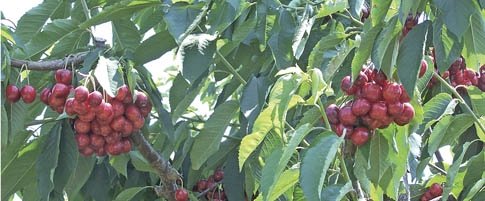
Cherry growers in The Dalles, Oregon, are rapidly shifting to dwarfing rootstocks, partly because of concerns about labor shortages in the future, Lynn Long, Oregon State University Extension educator, reported at the annual Cherry Institute meeting in Yakima, Washington, in January.
Long said that a Washington nursery reported that 80 percent of the dwarfing cherry rootstocks it grew were sold in Oregon. Gisela 6 has been the most poplar, but growers in The Dalles are beginning to plant more G.12 and are interested in some Russian rootstocks, especially Krymsk 5 or Krymsk 6.
The dwarfing rootstocks enable them to develop pedestrian orchards that are easier to maintain and allow fruit to be harvested twice as fast as with large trees, Long said, but the switch to dwarfing rootstocks and more intensive orchards is driven also by economics. Agricultural economists have shown that it takes eight years to recover the investment for a moderately dense planting on Gisela rootstocks, compared with up to 15 years for an orchard with standard trees on Mazzard rootstocks.
Krymsk
Growers are interested in the Krymsk rootstocks because they seem to have the same attributes and advantages as Gisela 6 or 12, Long explained. They are precocious, productive, and dwarfing. Although K.5 does not seem to be as productive as G.6, he said that might be an advantage because it’s less likely to overcrop. Trees on K.5 have good leaf size and good vigor, which is exactly what’s needed in order to grow large fruit. Krymsk 6 is probably between G.5 and G.6 in size, Long estimated, which gives growers a range of sizes to choose from.
Another advantage of the Krymsk rootstocks is the cost. Growers pay a premium of about $3.50 per tree for Gisela rootstocks, but only about $1 per tree for the Krymsk.
In 2006, the cooperative Oregon Cherry Growers bought about 50,000 trees on Krymsk rootstocks for planting in The Dalles area, Long reported. “We’re going to be learning a lot about these Krymsk rootstocks in the near future.”
Risks
But there are risks involved, he added. Apart from the concern about fruit size on productive rootstocks, both of the Krymsk rootstocks are hypersensitive to prune dwarf virus and prunus necrotic ring spot.
“We rejected G.7 years ago because it was hypersentitive to those two viruses, and yet we have had G.7 planted in Washington State and the Mid-Columbia area of Oregon for the last ten years, and we’re not seeing that they’re dying out,” he said. “We’re not seeing it as the problem we saw it as a few years ago.”
Though growers are planting a lot of trees on dwarfing rootstocks, they don’t have everything figured out yet, he stressed. “We’re learning. We’re still struggling with fruit size on these productive rootstocks.”
Long said one grower told him he had Lapins on a number of different Gisela rootstocks, including G.5, G.6, and G.7. In 2006, the plantings produced 12 tons per acre, but the fruit was not as large as it should have been, and the trees started to shut down.
Last year, after he pruned the trees very hard and brought production down to around seven tons per acre, 95 percent of his cherries were 9.5 row and larger.
With Lapins on Krymsk, the same grower had eight tons per acre of 9.5 row and larger. One of the secrets to growing large fruit on these productive rootstocks is in the pruning, Long said. Oregon State University recently published a bulletin by Long called “Four Simple Steps to Pruning Cherry Trees on Gisela and Other Productive Rootstocks.” It is available in English and Spanish and can be downloaded free at http://extension.oregonstate. edu/catalog/pdf/pnw/pnw592.pdf.

Leave A Comment